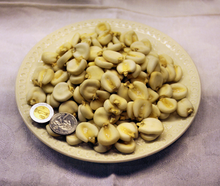- Hominy
-
Hominy or nixtamal is dried maize kernels which have been treated with an alkali in a process called nixtamalization.
The English term hominy is derived from the Powhatan language word for maize. Many other Native American cultures also made hominy and integrated it into their diet. Cherokees, for example, made hominy grits by soaking corn in a weak lye solution obtained by leaching hardwood ash with water and beating it with a kanona (ᎧᏃᎾ), or corn beater. The grits were used to make a traditional hominy soup (gvnohenv amagii ᎬᏃᎮᏅ ᎠᎹᎩᎢ), a hominy soup that was allowed to ferment (gvwi sida amagii ᎬᏫ ᏏᏓ ᎠᎹᎩᎢ), cornbread, dumplings (digunvi ᏗᎫᏅᎢ), or, in post-contact times, fried with bacon and green onions.
Some recipes using hominy include menudo (a spicy tripe and hominy soup), pozole or posole (a stew of hominy and pork, chicken, or other meat), hominy bread, hominy chili, hog n' hominy, casseroles and fried dishes. Hominy can be ground coarsely to make hominy grits, or into a fine mash (dough) to make masa, a dough used regularly in Latin American cuisine. Many islands in the West Indies, most notably Jamaica, also use hominy to make a sort of porridge with corn starch or flour to harden the mixture and condensed milk, vanilla and nutmeg to taste.
The earliest known usage of nixtamalization was in what is present-day southern Mexico and Guatemala around 1500–1200 BC.
Soaking the corn in lye kills the seed's germ, which keeps it from sprouting while in storage. In addition to preserving the grain as foodstuff, this process also affords several significant nutritional advantages over untreated maize products. It converts some of the niacin (and possibly other B vitamins) into a form more absorbable by the body, improves the availability of the amino acids, and (at least in the lime-treated variant) supplements the calcium content, balancing maize's comparative excess of phosphorus.
Rockihominy, a popular trail food in the 19th and early 20th centuries, is dried corn roasted to a golden brown, then ground to a very coarse meal, almost like hominy grits. Hominy is also used as animal feed.
See also
External links
- The Mountain Laurel (2005). Homemade Hominy. Retrieved June 18, 2005.
- Ha-pah-shu-tse (2005). Hominy Products. Retrieved June 18, 2005.[dead link]
- Native Way Cookbook Gv-No-He-Nv A-Ma-Gi-i, Gv-Wi Si-Da A-Ma-Gi-i and Di-Gu-Nv-i.
- wonderfulingredients.com Recipe for White Bean, Hominy and Chipotle Soup
- Beans Beans Beans White Bean and Hominy Chili
Maize (corn) Varieties Baby · Blue · Field · Flint · MON 810 · MON 863 · Quality Protein Maize · Shoepeg · Sweet · Transgenic maize · Waxy · Bolivia varieties · Ecuador varieties · Italian varieties · Sweetcorn varieties
Parts Processing Pathology Corn-based products Raw materials Beverages Dishes Bread · Cookie · Corn flakes · Corn on the cob · Fufu · Grits · Hominy · Mazamorra · Mush · Pap · Piki · Polenta · Popcorn · Pudding corn · Sadza · Shawnee cakeCorn syrup Glucose syrup · High-fructose corn syrup (Health effects · Public relations) · High maltose corn syrupNon-food Categories:- Algonquian loanwords
- Maize products
- Mexican cuisine
- Mexican ingredients
- Native American cuisine
- Cuisine of the Southern United States
- Crops originating from Mexico
Wikimedia Foundation. 2010.


